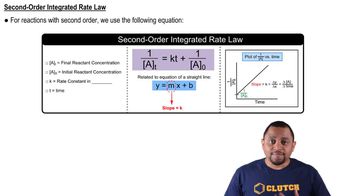Here are the essential concepts you must grasp in order to answer the question correctly.
Second-Order Reactions
A second-order reaction is one where the rate of reaction is proportional to the square of the concentration of one reactant or to the product of the concentrations of two reactants. For a reaction involving a single reactant, the rate law can be expressed as rate = k[C]^2, where k is the rate constant and [C] is the concentration of the reactant. This type of reaction typically leads to a specific integrated rate law that can be used to calculate concentration changes over time.
Recommended video:
Integrated Rate Law for Second-Order Reactions
The integrated rate law for a second-order reaction can be expressed as 1/[A] = 1/[A]₀ + kt, where [A] is the concentration at time t, [A]₀ is the initial concentration, k is the rate constant, and t is the time elapsed. This equation allows us to determine the concentration of the reactant at any given time, making it essential for solving problems related to concentration changes in second-order kinetics.
Recommended video:
Units of Rate Constant
The units of the rate constant (k) for a second-order reaction are M^-1 s^-1, indicating that the rate of reaction depends on the concentration of the reactant squared. Understanding the units is crucial for ensuring that calculations involving the rate constant and concentrations are dimensionally consistent, which is necessary for accurate results in kinetics problems.
Recommended video:
 Verified step by step guidance
Verified step by step guidance

